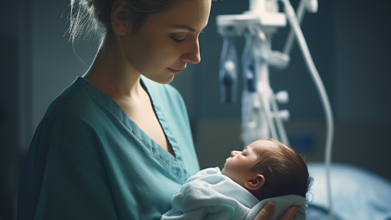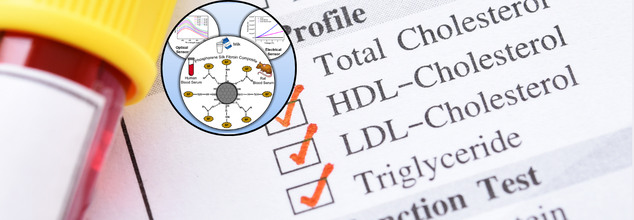- Health Conditions A-Z
- Health & Wellness
- Nutrition
- Fitness
- Health News
- Ayurveda
- Videos
- Medicine A-Z
- Parenting
- Web Stories

New Study Finds Plastics From Nanomedicines Could Be Transferred To Embryos
A new study published in Environment International has revealed Nanoplastics can still build up in newborn hearts that shed a new light on how such small plastic particle can create such a major hazard in our physical health.
What Are Nanoplastics?
It’s no secret that plastic has become an overabundant material in our daily use, from the cups we use at cafes to the packaging material for every small gift. Plastics that have been exposed to nature in particular start shedding small ‘nanoplastic’ particles wherever they go. Now, these tiny particles are posing a major problem.
From the oceans where we get our fish, to the soil where our plants are being uprooted to our very blood, nanoplastics have gotten anywhere. The presence of these particles in the human body pose a particular concern, as the researchers started to ask the question: what happens now if these nanoplastics are present inside newborns of the coming generation.
How Was The Study Conducted?
The study was conducted on chicken embryos by a group of researchers from Leiden University. According to the researchers, the study was conducted on chicken embryos, as it is easier to inject substances and take precise, observable measurements to see how the embryo develops inside the mother’s womb.
Since these nanoparticles are so small, it’s practically impossible to see them through conventional microscopes. As a result, the progress is tracked by tagging the nanoparticles with a clearly visible metal.
Their main finding was that these nanoplastics are capable of crossing the walls of the blood vessels themselves, leading them to build up to relatively high levels in the hart and kidneys.
Interestingly enough, the researchers also found nanoplastics in the avascular heart cushions that do not contain blood vessels. This suggests that these nanoplastics could pass into the heart of the embryo, directly through the fenestrate, which is a small opening that plays a role in forming and remodeling the heart’s structure during its development.
The study could potentially lead interesting results for the future, as we better our understanding of how these nanoplastics are spread to such an extent. Even if the outlook isn’t necessarily good, it could bring a change to how we approach our plastic consumption. As of right now, there’s already an understanding of how there needs to be more mindful use of nanomedicines when it comes to pregnant women.

Scientist Reveal New Optical Sensor Can Spot High Cholesterol And Predict Disease Risk Instantly
A future where heart attacks, strokes, and even cancer might be predictable is coming near—not only cured—thanks to a small, new eco-friendly sensor that can detect harmful levels of cholesterol in real-time. Scientists in India have created a revolutionizing optical sensor that can immediately identify high cholesterol, which could change the way we check for heart disease around the world.
At the core of this innovation is a unique biosensing platform that's not just extremely sensitive and affordable but also eco-friendly. Created by scientists at the Institute of Advanced Study in Science and Technology (IASST), Guwahati, in India this next-generation optical sensing tool is constructed using silk fiber functionalized with phosphorene quantum dots. Their work, reported in the highly regarded Nanoscale journal by the Royal Society of Chemistry, breaks new ground for non-invasive, real-time disease monitoring.
Why Early Detection of Cholesterol is Important to Overall Health?
Elevated cholesterol levels, particularly high LDL (low-density lipoprotein) or "bad" cholesterol, are frequently associated with silent but lethal diseases such as atherosclerosis, myocardial infarction, hypertension, venous thrombosis, and even some cancers. But the greatest concern? Most individuals never realize they're at risk until it's too late.
Cholesterol serves a double function in human physiology. It is required for the manufacture of vitamin D, bile acids, and steroid hormones and for the preservation of blood and nerve cell integrity. But too much—especially increased LDL (low-density lipoprotein, or "bad") and decreased HDL (high-density lipoprotein, or "good") cholesterol—can cause arteries to become clogged with plaque, blocking the flow of blood and causing life-threatening events.
That's why it is essential to detect these issues early on. And this new optical sensor might prove a breakthrough in the global battle against chronic illnesses by detecting risk signs before symptoms develop.
What makes this device a scientific milestone is the integration of materials and techniques that are innovative and environmentally friendly. The scientists employed silk fiber as the substrate and functionalized it with phosphorene quantum dots, which are renowned for their superior electrical and optical properties.
The sensor was also incorporated into a cellulose nitrate membrane to create an electrical sensing platform that can detect trace amounts of cholesterol—even below the normal detection limit. That's correct: this device can detect cholesterol changes before they reach clinical levels, making it perfect for regular health monitoring and preventive medicine.
This device produces no electronic waste, providing a green alternative to traditional diagnostic technologies.
How Does the Device Works?
In contrast to most experimental laboratory creations that fail to translate to real-world use, this device is highly compatible with real biological samples. It was able to detect cholesterol levels in human blood serum, rat blood, and even milk—showing its strength and versatility across mediums.
Such reliability makes it extremely versatile for application in point-of-care (POC) environments, possibly in clinics, pharmacies, or even at home. That translates to no more complicated lab tests or weeks of waiting for results.
One of the main causes of abnormal cholesterol is familial hypercholesterolemia, a genetic condition in which the liver has difficulty breaking down cholesterol. This makes regular checks even more crucial, particularly for those with a family history of heart disease, says the British Heart Foundation.
Obesity, inflammation, smoking, alcohol consumption, and sedentary lifestyles all increase LDL levels while simultaneously reducing protective HDL cholesterol. In many cases, the symptoms remain invisible—making it a ticking time bomb inside the body.
Visible signs such as deposits of fat beneath the skin (xanthomas), yellowish spots on or near the eyelids (xanthelasmas), or white circles around the iris (corneal arcus) may appear in rare cases. But for many individuals, high cholesterol has no warning signals.
Can Lifestyle Changes Replace Statins?
Though statins, drugs that inhibit the liver production of cholesterol—are common and have been shown to be effective, they're not the only solution. Lifestyle modification continues to be the cornerstone. Physicians suggest:
Physical activity on a daily basis: A minimum of 30 minutes to increase HDL and decrease LDL.
Changes in diet: Increased fiber, reduced saturated fats, and decreased processed foods.
Smoking and alcohol avoidance: Both are bad habits that make LDL worse and are detrimental to heart health.
The objective isn't merely treatment but prevention, and that is where early diagnosis using devices like this optical sensor comes into play.
This emerging optical sensor, capable of detecting cholesterol, is more than an academic achievement—it's a sea change. It signals a new world where your health is cared for proactively, sustainably, and customarily. Beyond its current ability to be handheld, this equipment may be designed into wearable devices, home health test kits, or even phones that are smarter with health attachments.

Credits: Canva
Common Medicines 'In Your Cabinet' Are Putting Your Heart At High Risk
Our medicine cabinets are stocked with a combination of prescription medications, over-the-counter painkillers, antidepressants, and supplements—all designed to keep us healthy but new research is now revealing an important and overlooked reality that some of the most widely used medications might be harming us more than they're helping, particularly when it comes to your blood pressure and heart health.
High blood pressure—or hypertension—affects over 1 billion people globally, and it’s one of the biggest risk factors for heart disease, stroke, and premature death. Yet, despite taking medications that are designed to manage it, many patients continue to struggle with uncontrolled blood pressure levels. Why? Experts are beginning to suspect that the answer might lie in a surprising culprit, the other medications we’re taking at the same time.
A new study by University of Pennsylvania researchers, reported in Hypertension Research, shows how widely used blood pressure medications might actually disrupt a critical heart-protective enzyme known as ACE2. And that's not all—other popular medications such as NSAIDs (say ibuprofen), antidepressants, steroids, and even decongestants might also be quietly jacking up blood pressure in millions of people without alerting them.
Cardiovascular disease is still the major killer globally, and high blood pressure—or hypertension—is a big contributor. Estimated to afflict more than a billion individuals worldwide, the hypertension burden is particularly crushing in low- and middle-income nations. Even with the universal availability of prescription drugs, many patients still struggle with uncontrolled blood pressure. Increasing evidence now implies that the very drugs we trust—prescription and over-the-counter—may be stealthily sabotaging cardiovascular health.
Could Your Blood Pressure Medications Be Damaging Your Heart?
Recent research indicates that most widely prescribed drugs can get in the way of blood pressure control. One in five hypertensive adults may be taking drugs that increase blood pressure, yet unaware of this.
From over-the-counter analgesics to antidepressants and oral steroids, the roll call of offenders is long. NSAIDs such as ibuprofen, some antidepressants, corticosteroids, decongestants, and even some oral contraceptives have all been shown to raise blood pressure levels. This poses very serious questions about how polypharmacy—taking several medications simultaneously—is likely to impact long-term cardiovascular health.
Experts point out, even moderate rises in blood pressure can contribute to major consequences on heart disease and stroke susceptibility. We should be more observant regarding reviewing medication, particularly in older populations who are already at risk.
ACE inhibitors (ACEIs) and angiotensin receptor blockers (ARBs) are widely used to manage hypertension by acting on the renin-angiotensin system (RAS). But research in Hypertension Research by researchers at the University of Pennsylvania brings new understanding to a crucial part of the puzzle: the ACE2 enzyme.
ACE2 performs a dual function—it both regulates blood pressure and is cardioprotective. It metabolizes angiotensin II, a strong vasoconstrictor, to angiotensin 1–7, which is a vasodilator and decreases blood pressure.
Dr. Henry Daniell and colleagues discovered that in companion animals already on ACEIs or ARBs, supplementing with oral ACE2 (administered through a new plant-based system) produced startling and alarming outcomes. Certain ACE inhibitors seemed to block the action of the ACE2 enzyme, essentially negating the therapeutic advantage of its supplementation. ARBs, on the other hand, appeared to enlarge the pool of angiotensin II—exactly what hypertensive patients try to escape.
Not all the ACE inhibitors reacted in a similar way. One of the most commonly prescribed medications in America, lisinopril, caused the smallest level of ACE2 inhibition and potentially could be considered a safe one for sustained cardiovascular support.
"You don't want to block ACE2, and you don't want to add to the angiotensin II pool. And we saw both there," explained Daniell.
ACE2 has been under the limelight ever since the COVID-19 pandemic, as the virus exploits this enzyme to gain entry into human cells. The inhibition of ACE2 by some blood pressure drugs eerily resembles what scientists witnessed in the initial stages of the pandemic.
Dr. Daniell and his colleagues are currently pursuing FDA approval to test their plant-based delivery system for ACE2 in humans, the first FDA-approved human blood protein expressed in plant cells to move into clinical trials. Their research may open the door to a new generation of cardiopulmonary therapies that are safer, more targeted, and possibly more effective.
Are You Taking a Medication That's Raising Your BP?
A concerning 19% of individuals with high blood pressure take at least one drug that has been shown to increase blood pressure, with women faring worse (24% vs. 14% of men). Sometimes the problem isn't the high blood pressure—it's the additive effect of too many drugs with overlapping actions.
Health experts are now advocating for a more cautious, individualized approach. Rather than simply increasing the dose or number of medications, doctors are exploring “deprescribing” as a strategy—removing or replacing drugs that may be doing more harm than good.
Natural Ways to Manage High Blood Pressure
If you’re worried about your heart health or want to complement your existing treatment, there are natural ways to support healthy blood pressure:
1. Follow a DASH Diet
Fruits, vegetables, whole grains, and low-fat dairy foods are the mainstays of the clinically tested Dietary Approaches to Stop Hypertension (DASH) diet, which lowers blood pressure.
2. Reduce Sodium
Cutting back on salt to less than 2,300 mg/day can make a quantifiable impact on your blood pressure level.
3. Boost Potassium
Bananas, spinach, avocados, and sweet potatoes are great sources of potassium, which counteracts sodium.
4. Get Moving
Try for at least 30 minutes of moderate exercise (such as brisk walking) five days a week. Regular exercise makes your heart stronger and boosts circulation.
5. Stay at a Healthy Weight
Even a small amount of weight loss can help reduce blood pressure in overweight people.
6. Reduce Stress
Recurring stress is a well-known cause of hypertension. Methods such as deep breathing, meditation, yoga, or even daily hobbies can reduce stress greatly.
7. Reduce Alcohol and Stop Smoking
Both tobacco and alcohol can raise blood pressure and harm your cardiovascular system. Reducing or stopping them all together has great heart health rewards.
While new research is still coming out, the connection between medications and heart health is becoming more intricate than originally realized. Whether you're dealing with hypertension or just want to shield your heart, it's important to examine all medications—both prescription and over-the-counter—and stay up to date regularly.

Credits: Canva
Depression Rates Surge Globally In Last 10 Years: Study
Depression is emerging as one of the most prevalent mental disorders globally. Cases among the adolescents and adults are on the rise. As per the recent report from the National Center for Health Statistics, the prevalence of depression in individuals aged 12 and older has in fact seen a surge of 60% over the last decade.
The study covered the period from August 2021 to August 2023 and found a 13/1% increase of US population reporting to have experienced depression. This is a significant increased as compared to the 8.2% observed between 2013 and 2014. Experts have advised it to be an alarming trend that reflects a broader global mental health crisis that demands urgent attention.
Has There Been Any Disparities In Depression Numbers?
The study, conducted by Debra J. Brody and Jeffrey P. Hughes of the National Center for Health Statistics, reveals some stark disparities in depression prevalence. Notably, women are more likely to experience depression than men, with 16% of women reporting symptoms compared to 10.1% of men. Depression is also more common among younger people, with nearly 20% of individuals aged 12 to 19 reporting depressive symptoms. In contrast, only 8.7% of adults aged 60 and above experienced depression. Moreover, socioeconomic factors play a significant role, with those living below the poverty line experiencing depression at rates higher than 20%.
How Does It Impact Day-To-Day Life?
The effects of depression can be lasting. It affects not just the person's mental health, but also the ability to function in daily life. As per the study, nearly 88% of individuals with depression report difficulties in their work, home, and social activities due to their symptoms. Despite the widespread impact of depression, a significant portion of those affected do not seek professional help. The study found that only 39.3% of individuals with depression received therapy or counseling in the past year, with women more likely to seek treatment than men (43% compared to 33.2%).
Global Statistics: What WHO Tells
Globally, depression remains a leading cause of disability, affecting approximately 280 million people, according to the World Health Organization (WHO). Women are particularly vulnerable, with depression being 50% more common in women than men. Additionally, depression is a leading cause of suicide, with over 700,000 people dying by suicide every year. The situation is exacerbated in low- and middle-income countries, where more than 75% of people with mental health disorders receive no treatment. Stigma, a lack of trained healthcare providers, and insufficient investment in mental health care contribute to the widespread lack of support.
What Is Depression?
Depression is characterized by persistent feelings of sadness, irritability, and a loss of interest in previously enjoyable activities. Other symptoms include poor concentration, feelings of guilt, disrupted sleep, changes in appetite, and a general lack of energy. These symptoms can last for weeks or even months, severely impacting an individual's quality of life. The WHO categorizes depression into different types, including single episode depression, recurrent depressive disorder, and bipolar disorder, with varying degrees of severity and duration.
© 2024 Bennett, Coleman & Company Limited

